lock LINCOLN MKC 2015 Owners Manual
[x] Cancel search | Manufacturer: LINCOLN, Model Year: 2015, Model line: MKC, Model: LINCOLN MKC 2015Pages: 490, PDF Size: 4.74 MB
Page 4 of 490
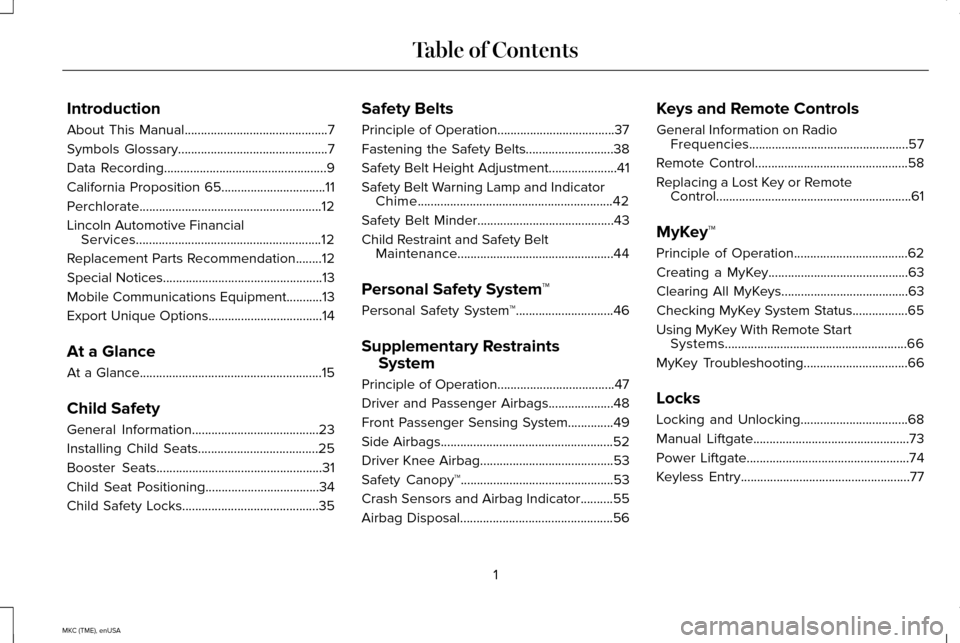
Introduction
About This Manual............................................7
Symbols Glossary
..............................................7
Data Recording
..................................................9
California Proposition 65................................11
Perchlorate........................................................12
Lincoln Automotive Financial Services
.........................................................12
Replacement Parts Recommendation........12
Special Notices
.................................................13
Mobile Communications Equipment...........13
Export Unique Options...................................14
At a Glance
At a Glance........................................................15
Child Safety
General Information
.......................................23
Installing Child Seats
.....................................25
Booster Seats...................................................31
Child Seat Positioning...................................34
Child Safety Locks..........................................35 Safety Belts
Principle of Operation....................................37
Fastening the Safety Belts...........................38
Safety Belt Height Adjustment
.....................41
Safety Belt Warning Lamp and Indicator Chime............................................................42
Safety Belt Minder..........................................43
Child Restraint and Safety Belt Maintenance................................................44
Personal Safety System ™
Personal Safety System ™
..............................46
Supplementary Restraints System
Principle of Operation
....................................47
Driver and Passenger Airbags....................48
Front Passenger Sensing System
..............49
Side Airbags
.....................................................52
Driver Knee Airbag.........................................53
Safety Canopy™...............................................53
Crash Sensors and Airbag Indicator..........55
Airbag Disposal
...............................................56 Keys and Remote Controls
General Information on Radio
Frequencies.................................................57
Remote Control
...............................................58
Replacing a Lost Key or Remote Control............................................................61
MyKey™
Principle of Operation...................................62
Creating a MyKey...........................................63
Clearing All MyKeys.......................................63
Checking MyKey System Status
.................65
Using MyKey With Remote Start Systems........................................................66
MyKey Troubleshooting
................................66
Locks
Locking and Unlocking
.................................68
Manual Liftgate................................................73
Power Liftgate..................................................74
Keyless Entry
....................................................77
1
MKC (TME), enUSA Table of Contents
Page 6 of 490
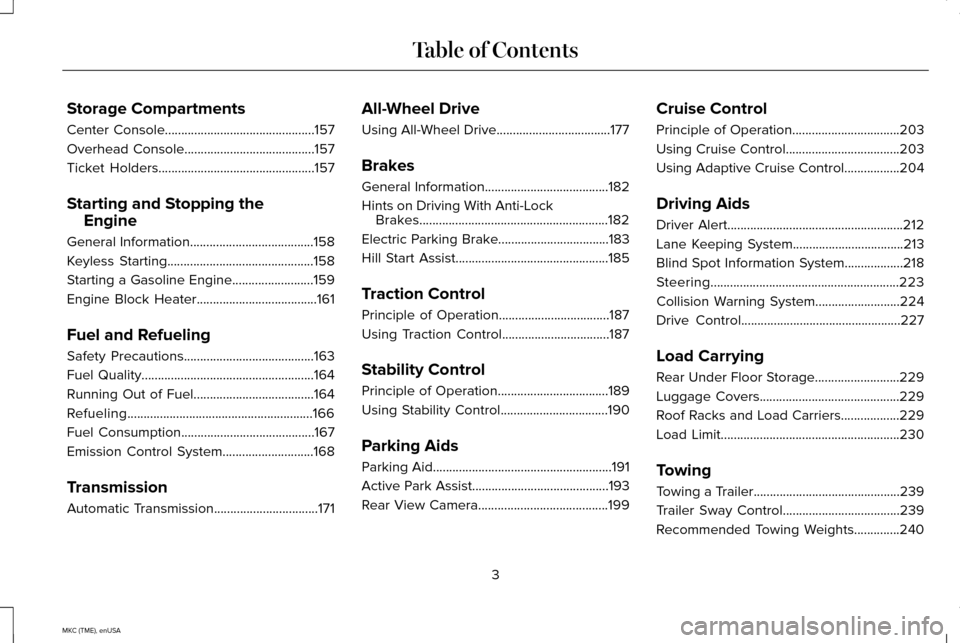
Storage Compartments
Center Console..............................................157
Overhead Console........................................157
Ticket Holders
................................................157
Starting and Stopping the Engine
General Information......................................158
Keyless Starting
.............................................158
Starting a Gasoline Engine.........................159
Engine Block Heater.....................................161
Fuel and Refueling
Safety Precautions
........................................163
Fuel Quality
.....................................................164
Running Out of Fuel
.....................................164
Refueling.........................................................166
Fuel Consumption
.........................................167
Emission Control System
............................168
Transmission
Automatic Transmission................................171 All-Wheel Drive
Using All-Wheel Drive...................................177
Brakes
General Information
......................................182
Hints on Driving With Anti-Lock Brakes
..........................................................182
Electric Parking Brake
..................................183
Hill Start Assist...............................................185
Traction Control
Principle of Operation..................................187
Using Traction Control
.................................187
Stability Control
Principle of Operation..................................189
Using Stability Control.................................190
Parking Aids
Parking Aid
.......................................................191
Active Park Assist..........................................193
Rear View Camera........................................199 Cruise Control
Principle of Operation.................................203
Using Cruise Control...................................203
Using Adaptive Cruise Control.................204
Driving Aids
Driver Alert
......................................................212
Lane Keeping System..................................213
Blind Spot Information System
..................218
Steering..........................................................223
Collision Warning System
..........................224
Drive Control
.................................................227
Load Carrying
Rear Under Floor Storage..........................229
Luggage Covers...........................................229
Roof Racks and Load Carriers
..................229
Load Limit
.......................................................230
Towing
Towing a Trailer
.............................................239
Trailer Sway Control....................................239
Recommended Towing Weights..............240
3
MKC (TME), enUSA Table of Contents
Page 11 of 490

Safety alert
See Owner's Manual
Air conditioning system
Anti-lock braking system
Avoid smoking, flames or sparks
Battery
Battery acid
Brake fluid - non petroleum based
Brake system Cabin air filter
Check fuel cap
Child safety door lock or unlock
Child seat lower anchor
Child seat tether anchor
Cruise control
Do not open when hot
Engine air filter
Engine coolant Engine coolant temperature
Engine oil
Explosive gas
Fan warning
Fasten safety belt
Front airbag
Front fog lamps
Fuel pump reset
Fuse compartment
8
MKC (TME), enUSA Introduction E162384 E71340
Page 12 of 490
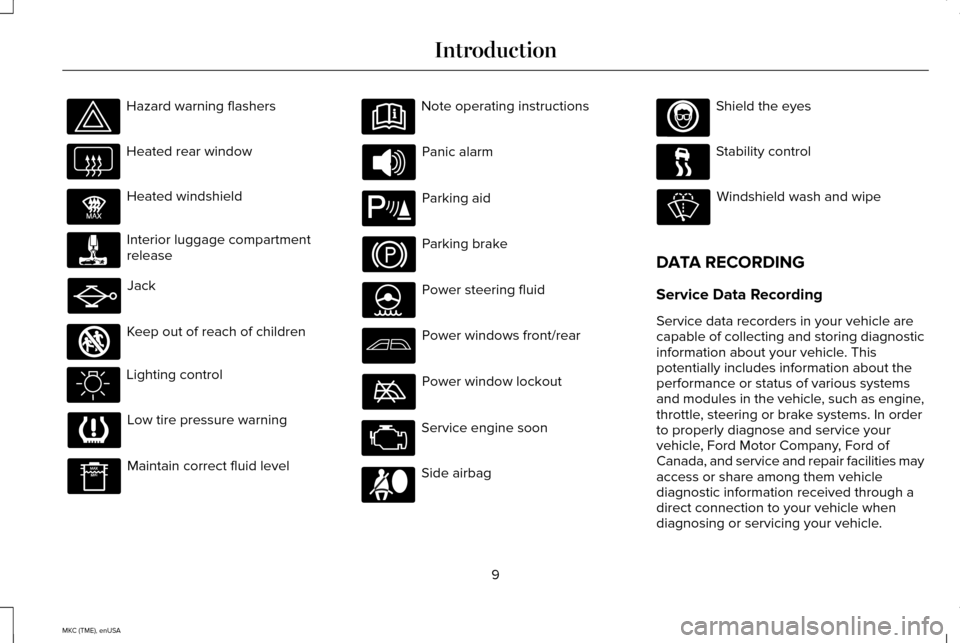
Hazard warning flashers
Heated rear window
Heated windshield
Interior luggage compartment
release
Jack
Keep out of reach of children
Lighting control
Low tire pressure warning
Maintain correct fluid level Note operating instructions
Panic alarm
Parking aid
Parking brake
Power steering fluid
Power windows front/rear
Power window lockout
Service engine soon
Side airbag Shield the eyes
Stability control
Windshield wash and wipe
DATA RECORDING
Service Data Recording
Service data recorders in your vehicle are
capable of collecting and storing diagnostic
information about your vehicle. This
potentially includes information about the
performance or status of various systems
and modules in the vehicle, such as engine,
throttle, steering or brake systems. In order
to properly diagnose and service your
vehicle, Ford Motor Company, Ford of
Canada, and service and repair facilities may
access or share among them vehicle
diagnostic information received through a
direct connection to your vehicle when
diagnosing or servicing your vehicle.
9
MKC (TME), enUSA Introduction E91392 E161353 E139213 E167012
Page 19 of 490
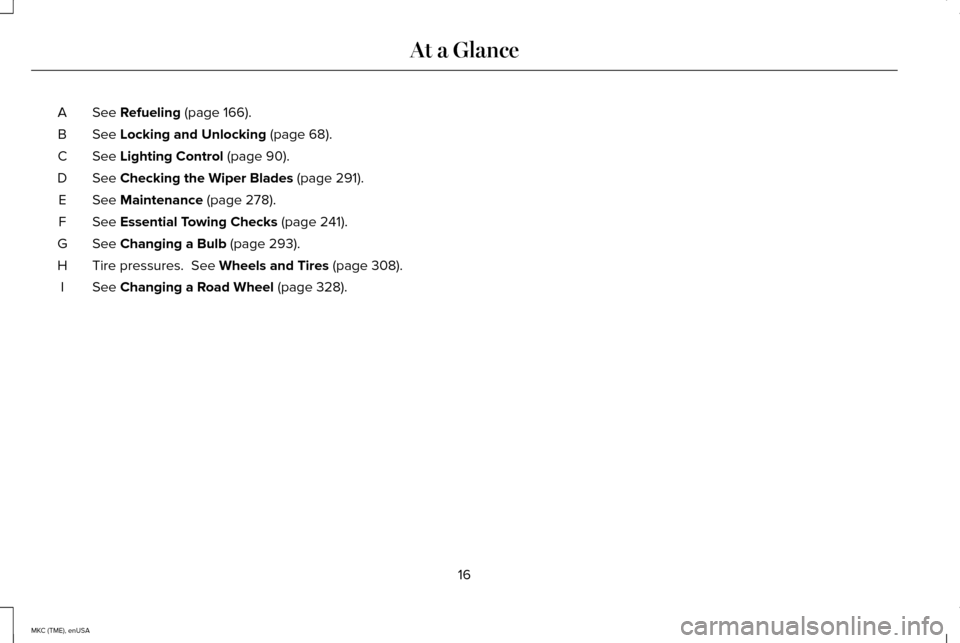
See Refueling (page 166).
A
See
Locking and Unlocking (page 68).
B
See
Lighting Control (page 90).
C
See
Checking the Wiper Blades (page 291).
D
See
Maintenance (page 278).
E
See
Essential Towing Checks (page 241).
F
See
Changing a Bulb (page 293).
G
Tire pressures.
See Wheels and Tires (page 308).
H
See
Changing a Road Wheel (page 328).
I
16
MKC (TME), enUSA At a Glance
Page 20 of 490
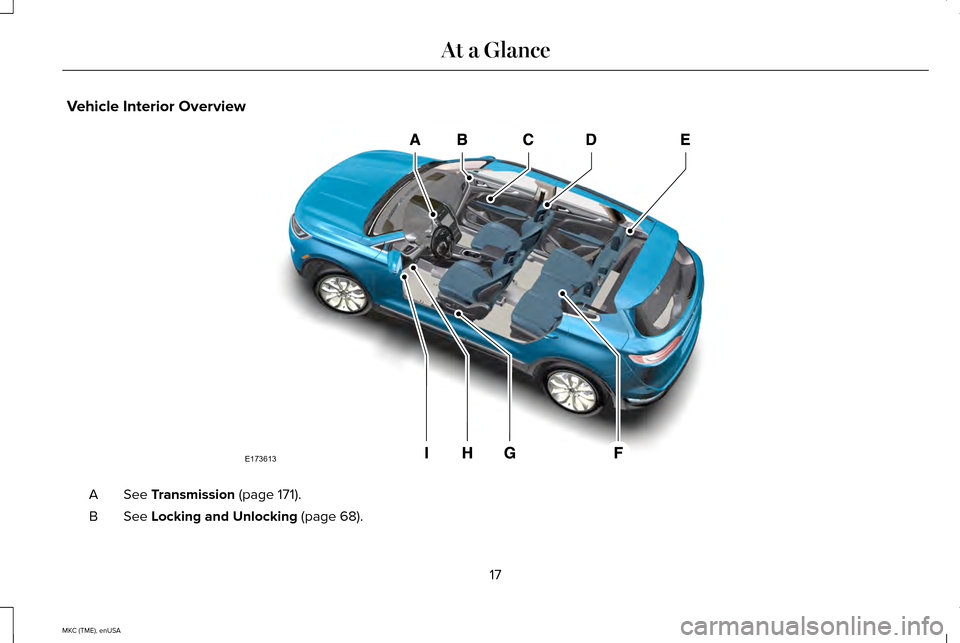
Vehicle Interior Overview
See Transmission (page 171).
A
See
Locking and Unlocking (page 68).
B
17
MKC (TME), enUSA At a GlanceE173613
Page 28 of 490
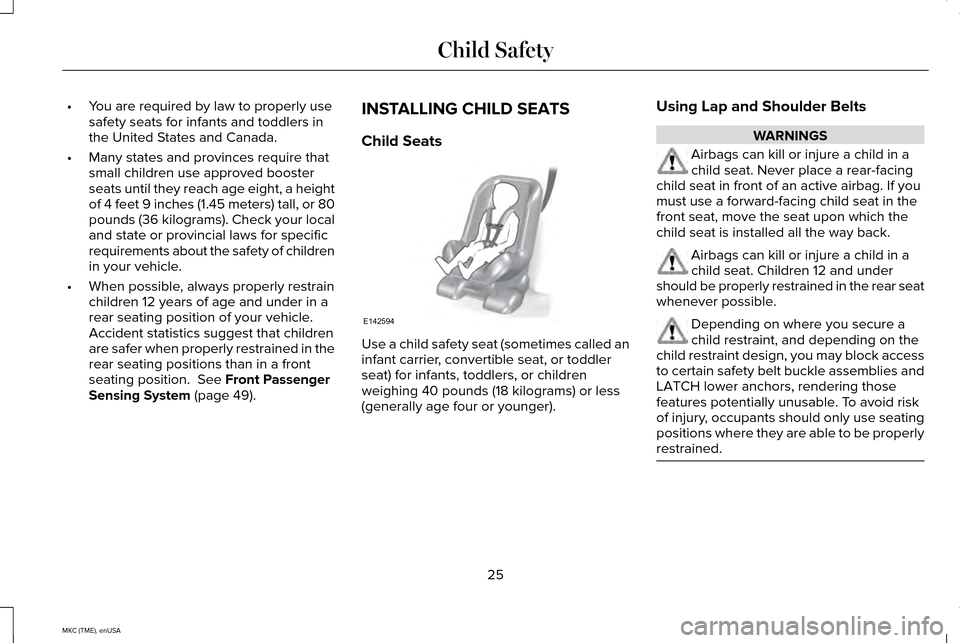
•
You are required by law to properly use
safety seats for infants and toddlers in
the United States and Canada.
• Many states and provinces require that
small children use approved booster
seats until they reach age eight, a height
of 4 feet 9 inches (1.45 meters) tall, or 80
pounds (36 kilograms). Check your local
and state or provincial laws for specific
requirements about the safety of children
in your vehicle.
• When possible, always properly restrain
children 12 years of age and under in a
rear seating position of your vehicle.
Accident statistics suggest that children
are safer when properly restrained in the
rear seating positions than in a front
seating position. See Front Passenger
Sensing System (page 49). INSTALLING CHILD SEATS
Child Seats
Use a child safety seat (sometimes called an
infant carrier, convertible seat, or toddler
seat) for infants, toddlers, or children
weighing 40 pounds (18 kilograms) or less
(generally age four or younger).Using Lap and Shoulder Belts WARNINGS
Airbags can kill or injure a child in a
child seat. Never place a rear-facing
child seat in front of an active airbag. If you
must use a forward-facing child seat in the
front seat, move the seat upon which the
child seat is installed all the way back. Airbags can kill or injure a child in a
child seat. Children 12 and under
should be properly restrained in the rear seat
whenever possible. Depending on where you secure a
child restraint, and depending on the
child restraint design, you may block access
to certain safety belt buckle assemblies and
LATCH lower anchors, rendering those
features potentially unusable. To avoid risk
of injury, occupants should only use seating
positions where they are able to be properly
restrained. 25
MKC (TME), enUSA Child SafetyE142594
Page 29 of 490
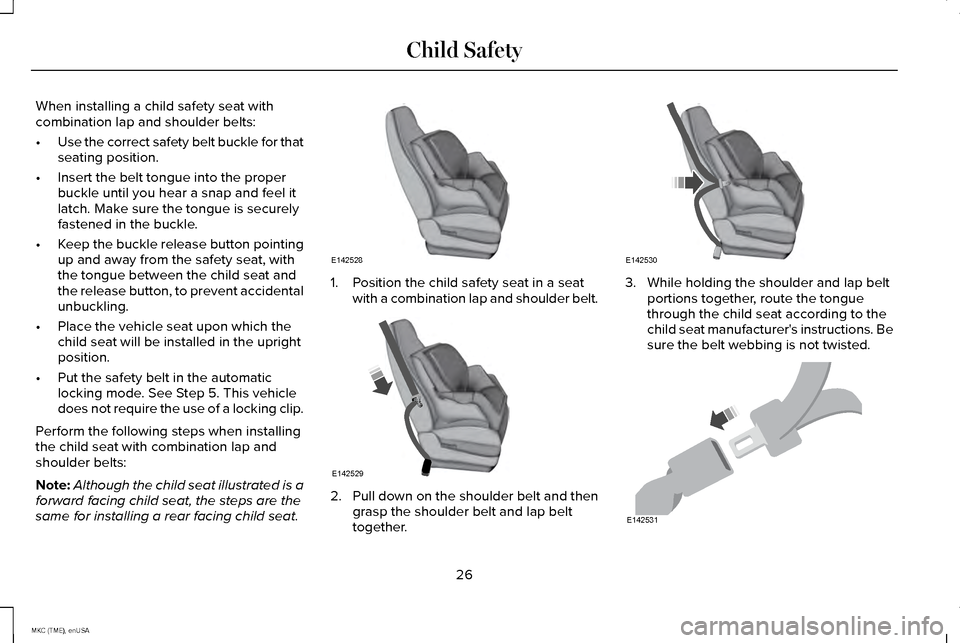
When installing a child safety seat with
combination lap and shoulder belts:
•
Use the correct safety belt buckle for that
seating position.
• Insert the belt tongue into the proper
buckle until you hear a snap and feel it
latch. Make sure the tongue is securely
fastened in the buckle.
• Keep the buckle release button pointing
up and away from the safety seat, with
the tongue between the child seat and
the release button, to prevent accidental
unbuckling.
• Place the vehicle seat upon which the
child seat will be installed in the upright
position.
• Put the safety belt in the automatic
locking mode. See Step 5. This vehicle
does not require the use of a locking clip.
Perform the following steps when installing
the child seat with combination lap and
shoulder belts:
Note: Although the child seat illustrated is a
forward facing child seat, the steps are the
same for installing a rear facing child seat. 1. Position the child safety seat in a seat
with a combination lap and shoulder belt. 2.
Pull down on the shoulder belt and then
grasp the shoulder belt and lap belt
together. 3. While holding the shoulder and lap belt
portions together, route the tongue
through the child seat according to the
child seat manufacturer's instructions. Be
sure the belt webbing is not twisted. 26
MKC (TME), enUSA Child SafetyE142528 E142529 E142530 E142531
Page 30 of 490
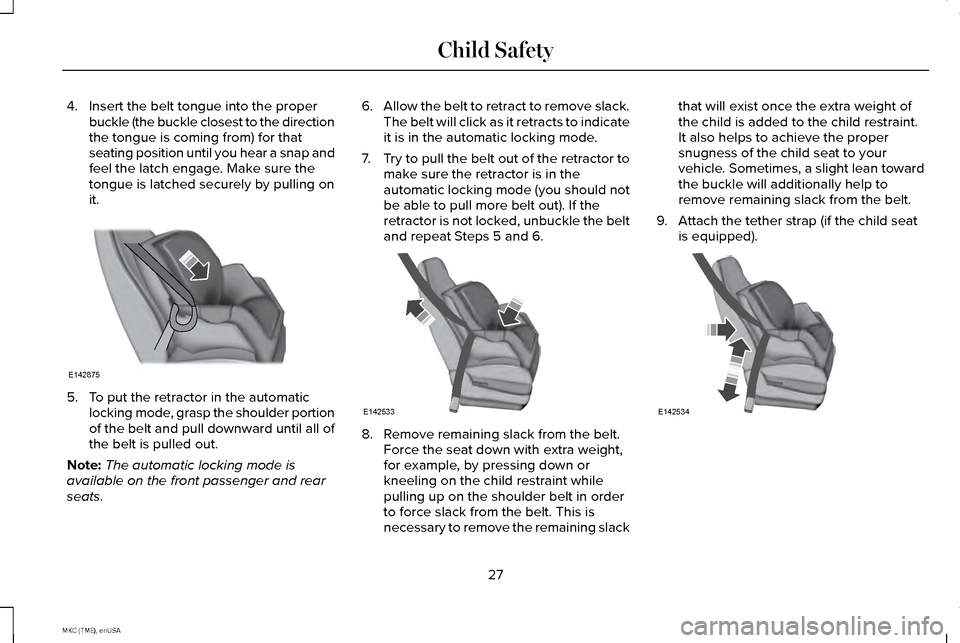
4. Insert the belt tongue into the proper
buckle (the buckle closest to the direction
the tongue is coming from) for that
seating position until you hear a snap and
feel the latch engage. Make sure the
tongue is latched securely by pulling on
it. 5. To put the retractor in the automatic
locking mode, grasp the shoulder portion
of the belt and pull downward until all of
the belt is pulled out.
Note: The automatic locking mode is
available on the front passenger and rear
seats. 6.
Allow the belt to retract to remove slack.
The belt will click as it retracts to indicate
it is in the automatic locking mode.
7. Try to pull the belt out of the retractor to
make sure the retractor is in the
automatic locking mode (you should not
be able to pull more belt out). If the
retractor is not locked, unbuckle the belt
and repeat Steps 5 and 6. 8. Remove remaining slack from the belt.
Force the seat down with extra weight,
for example, by pressing down or
kneeling on the child restraint while
pulling up on the shoulder belt in order
to force slack from the belt. This is
necessary to remove the remaining slack that will exist once the extra weight of
the child is added to the child restraint.
It also helps to achieve the proper
snugness of the child seat to your
vehicle. Sometimes, a slight lean toward
the buckle will additionally help to
remove remaining slack from the belt.
9. Attach the tether strap (if the child seat is equipped). 27
MKC (TME), enUSA Child SafetyE142875 E142533 E142534
Page 31 of 490
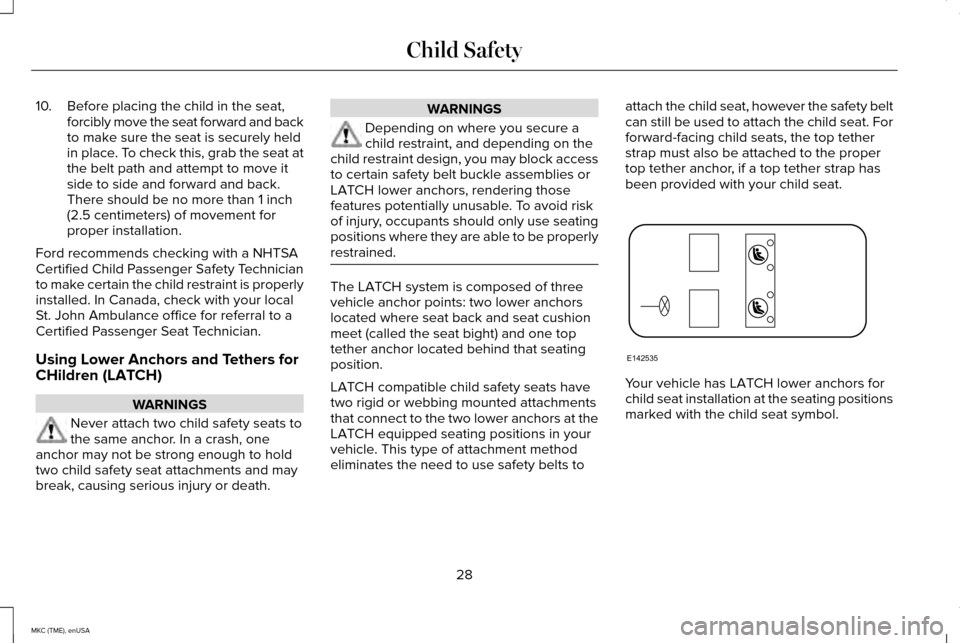
10. Before placing the child in the seat,
forcibly move the seat forward and back
to make sure the seat is securely held
in place. To check this, grab the seat at
the belt path and attempt to move it
side to side and forward and back.
There should be no more than 1 inch
(2.5 centimeters) of movement for
proper installation.
Ford recommends checking with a NHTSA
Certified Child Passenger Safety Technician
to make certain the child restraint is properly
installed. In Canada, check with your local
St. John Ambulance office for referral to a
Certified Passenger Seat Technician.
Using Lower Anchors and Tethers for
CHildren (LATCH) WARNINGS
Never attach two child safety seats to
the same anchor. In a crash, one
anchor may not be strong enough to hold
two child safety seat attachments and may
break, causing serious injury or death. WARNINGS
Depending on where you secure a
child restraint, and depending on the
child restraint design, you may block access
to certain safety belt buckle assemblies or
LATCH lower anchors, rendering those
features potentially unusable. To avoid risk
of injury, occupants should only use seating
positions where they are able to be properly
restrained. The LATCH system is composed of three
vehicle anchor points: two lower anchors
located where seat back and seat cushion
meet (called the seat bight) and one top
tether anchor located behind that seating
position.
LATCH compatible child safety seats have
two rigid or webbing mounted attachments
that connect to the two lower anchors at the
LATCH equipped seating positions in your
vehicle. This type of attachment method
eliminates the need to use safety belts toattach the child seat, however the safety belt
can still be used to attach the child seat. For
forward-facing child seats, the top tether
strap must also be attached to the proper
top tether anchor, if a top tether strap has
been provided with your child seat.
Your vehicle has LATCH lower anchors for
child seat installation at the seating positions
marked with the child seat symbol.
28
MKC (TME), enUSA Child SafetyE142535